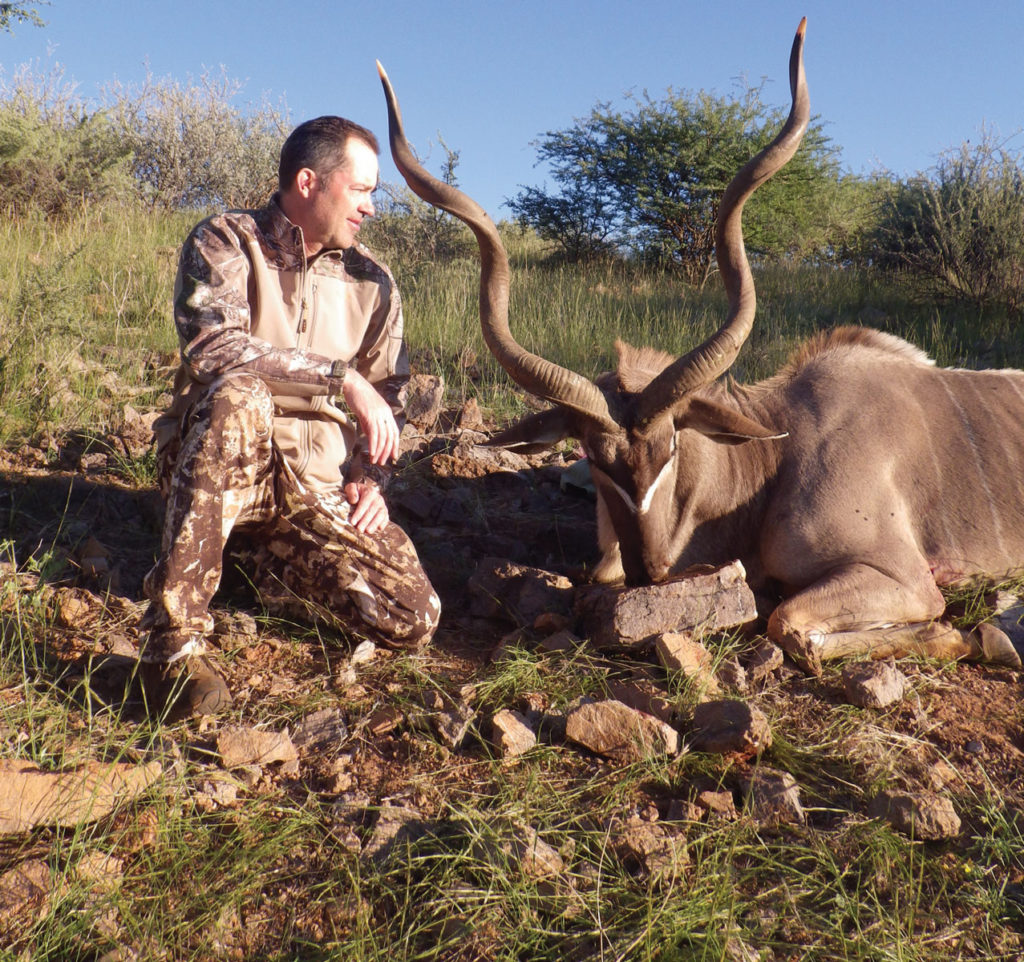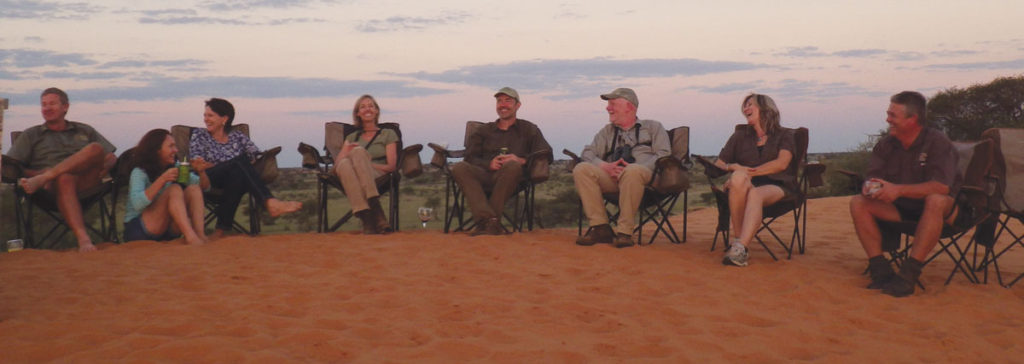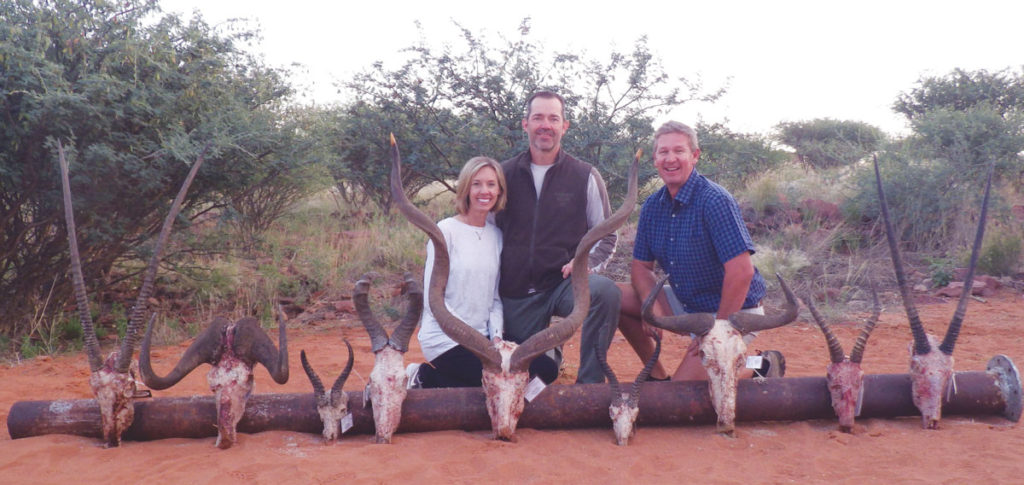The Five-Day Safari
February 5, 2020



 SCA Articles
SCA Articles

The final campfire of our safari was still smoldering when Jamy Traut and I drove away from his home base of Panorama and headed toward the Windhoek airport. Fueled almost entirely by a thermos of powerful black coffee, the conversation stumbled between highlights of the last three weeks to what we might do for an encore. Big plans were hatched, and I committed to the month of time necessary to make them happen. Leaving Africa is difficult, but knowing I would be back soon prevented the goodbye from becoming something less than graceful.
The long return flight from Africa offers a unique opportunity for following random thoughts down whatever path they might lead, and I found myself pondering just what could be accomplished by spending a short week in country. Once home and distracted by matters more pressing, any further consideration was dismissed.
Several months after returning, a chance conversation with a client who had a tight schedule and still wanted to give Africa a go turned the light back on, so I emailed Jamy and told him I knew of someone who wanted to try a five-day plains game hunt. I also told him that I wanted to observe the hunt, to experience it with someone who had never been on safari. Both he and Sporting Classics agreed, so I extended an open invitation to readers who might want to join us in last year’s July/August Adventures column. My client eventually decided he couldn’t make it work, but someone else took the bait.
Shane and Sarah Lanning were flying to Alaska for a family vacation. A long-time subscriber, Shane had his latest edition of Sporting Classics handy to pass the time. He read the column and, as he wrote in his journal:
I leaned over and asked Sarah if she wanted to go to Africa. She didn’t say no!
Shane made contact as soon as they returned. We agreed to firm dates and soon the Lannings had their first tickets to Africa in hand.
I met Shane and Sarah in Atlanta’s mammoth airport and any concerns about the trip being enjoyable just fell away. Over a quick meal, I learned that Shane was a lifelong hunter, having spent time afield with his father and uncle through his younger years. Lately, he had been focusing on annual trips out West and was also introducing their 10-year-old son, Chase, to the outdoors. To hear him tell it, Chase was every bit the natural hunter his birthright suggested.

Surprisingly, this would be Sarah’s first hunting trip. Hailing from Kansas, she was no stranger to the outdoors in general and seemed ready for anything. In fact, she was in such good humor about the upcoming adventure that Shane and I hatched a plan to convince her there was no toilet paper in Namibia. Gamefully, she grabbed what she could from their Johannesburg hotel room and, poised to add it to her backpack, called our bluff.
Jamy collected us at the Windhoek airport, stopped just long enough for a bite and still got us to Panorama in time for Shane to confirm zero and go on a short hunt. I joined the Lannings on the hunting rack. Jamy and his 16-year-old son, Nicky, stood just behind and spotted.
The amount of game we found in the next two hours was jaw-dropping. Kudu, gemsbok, springbok, blue and black wildebeest, impala, blesbok, mountain zebra and red hartebeest—all came out to feed in the late-afternoon sun. Bat-eared foxes trotted alongside the Land Cruiser and jackals yowled in the distance. Shane smiled broadly and Sarah couldn’t help but point at everything as it came into view. Seeing Africa through their first-time eyes was a thrill, so much so that my rifle stayed cased for the duration of their safari.
In his journal that evening, Shane wrote:
Passing under a tree, Sarah noticed some round bird nests and asked Jamy what species of birds made them. He replied that those weren’t bird nests. Rather, that is how a giraffe stores its food for the upcoming winter. Jamy didn’t start laughing until I had my camera out to take a picture. This is going to be a fun trip!
Topping a dune, Jamy picked out a springbok ram in the distance.
“Let’s go for a walk,” he suggested, and we hit the sand in a formation used for the rest of the trip. Jamy took the lead with Shane on his hip. Sarah was next, with Nicky and I alternately running drag.
Our cover held until we were about 100 yards from the ram. Jamy gave it a quick look and, since the horns were uneven, offered Shane the opportunity to take it as a cull. He made a great shot, and there was just enough afternoon light remaining for proper photography.
Before the hunt began, I had asked Shane about his concerns. Anticipating his reply might be one of the standards, like snakes, safe drinking water or quality of the meals. He surprised by responding that the hunting itself might be too easy. I had quickly assured him otherwise, and what we experienced the first full day proved me a sage.

We weren’t far into the morning’s drive before someone spotted a red hartebeest feeding through a big opening. After worming into reasonable shooting range, Jamy set the sticks and Shane slipped his rifle into the cradle. After Shane indicated he was steady, Jamy gave a careful look and determined the hartebeest was, maybe, two inches short of being a true trophy. Rather than being disappointed, Shane simply cleared his rifle’s chamber and smiled.
By the time the sun popped over the horizon, we had rock-hopped nearly to the crest of a big hill and were concentrating on a distant herd of blue wildebeest. Jamy thought the bull had promise, but the cover was so thick that there was only one way to find out. We scrambled back down and swung into the wind, moved quickly in an effort to catch up and stumbled into a pair of white rhinos.
Wildebeest no longer mattered, as the rhinos were close and at least one of them knew we were there. Jamy whispered some instructions as to the appropriate reaction if their convivial airs were dropped, and I wished for the comfort of the big rifle I’d left cased at the lodge. After a bit, we managed to get some unobstructed photos, then backed out and hustled to close ranks with the wildebeest.
By the time we caught up, the herd had moved into a swath of thick brush and trees. Jamy moved quietly forward with Shane in his hip pocket. Sarah and I found some deep shade and knelt down, and as we did, I felt a shift in the wind. In truth, the wind must have swirled around the wildebeest, as we soon heard them running along their back trail. The leading edge was just passing us when the bull swung into view, running hard on a course that would put him in our laps.
At about 25 yards the bull spotted us, turned himself inside out changing direction and then blew past Jamy and Shane. For some reason, he then slowed to a walk and Shane took his shot as the bull passed through an opening. It took some doing with all the tracks, but we managed to recover the wildebeest and discovered he was a little shorter than Jamy had hoped. That didn’t seem to faze Shane in the slightest, especially after he took a much larger bull later that morning.
During lunch, we learned that a superb black wildebeest had come in from a neighboring property and challenged one of the Panorama bulls for the collective attentions of his herd. It sounded like a great opportunity, so we shoveled our plates clean and were back on the truck in minutes. After a time, we managed to locate the herd and size up the bulls. Both were outstanding. This time the approach went perfectly and Shane made the shot from 130 yards.
Again, from Shane’s journal:
We end the afternoon watching a long hillside for kudu and locate several bulls. Jamy and I stalk into shooting distance for one he finally estimates at 52 inches. I tell him I had hoped for one that was wider. We backed out. I sure hope I don’t regret it.
While Jamy owns Panorama outright, he also holds the exclusive hunting rights to some 200,000 acres of private land in the immediate vicinity. This ensures minimal hunting pressure even in peak season, as well as trophy quality.

We hunted one of those properties the second morning, parking at the foot of a mountain range and then still-hunting along a game trail running through one of the main valleys. Africa only gets better when the truck is left behind, and the sights, sounds and smells that greeted us were as spectacular as any I’ve ever experienced. Shane was loving every minute of it. Sarah, even more.
I wasn’t really keeping track of time, but we were at least an hour into the hike when Shane’s rifle cracked. The bullet’s whomp came back, immediately followed by the pounding of hooves against the rocks. I froze until everyone else began inching forward and finally caught Shane’s eye. He mouthed “gemsbok.” We followed the blood trail for about 40 yards to where the old, long-horned cow had rolled to a stop. Even though the shot was snapped, it was perfect.
The plains remind me of Serengeti photos. Everywhere you look there is game. After the gemsbok is in the skinning shed, we headed into the dunes and stalked two blesbok rams. No shot.
Shane saw his first big kudu bull that afternoon. We found him from a distance, pinpointed his location, but never could get close enough for a shot. After losing him entirely, Jamy glassed up a brace of very good red hartebeest. In spite of everyone’s best efforts through multiple stalks, something always happened before the sticks could be set. Finally, we just ran out of daylight, though no one seemed to care.
It took Shane and Sarah until the third hunting day before fully adjusting to the time warp that seems to impact all those who hunt Africa. In my mind, this anomaly is more excitement than anything else, but they were both bright-eyed at breakfast. With three hunting days remaining, Shane wanted to concentrate on kudu at the expense of all else. Jamy agreed.
An hour later, we were looking over a loosely formed group of seven kudu bulls feeding along the top of a mountain. Among them was an elder who looked like he had it all. Up we went, and for the next three hours played hide-and-seek with so many kudu that I won’t offer a guess as to their number. If I did, you probably wouldn’t believe it anyway.
At one point, each of us was glued to our binoculars while trying to have a whispered discussion about the merits of visible bulls. What was being said didn’t make the slightest sense, so after a bit, I looked around and realized we were all looking at different groups! For all that, the big bull we climbed up to find never turned up.
I want to see a kudu, the chevron, looking back at me in my binoculars.
After returning to the Land Cruiser, we relocated to another vantage and found a sprawling plain full of springbok, mountain zebra, both flavors of wildebeest and a number of red hartebeest. With so many eyes watching, Jamy thought it best to slip in with Shane alone.
Sometime later, Sarah and I heard a shot, followed by an impact, and were soon admiring Shane’s heavy-horned red hartebeest. It had run some distance and then fallen quite near a trio of young rhino bulls, close enough so that one of us kept watch until the last picture was taken.
We spent the afternoon stalking through the dunes, hoping for kudu or possibly an eland. Early on, a very big springbok ram showed himself in the distance. After a quick scramble, Shane took his longest shot of the trip. Hit hard, the ram stayed on his feet while Shane wind-milled the bolt.
After things settled down, Sarah allowed, “Well, you sure cleared out this valley.” She had easily settled into the hunter’s rhythm, ribbing and all.
Long before the sun touched the horizon, a herd of mountain zebra popped into view. I didn’t think there was the slightest chance of getting close enough for a shot, as the cover was sparse, but Jamy and Shane gave it a try and the herd more-or-less walked in front of them. The old stallion Shane dropped was one of the safari’s finest trophies.
With only two days remaining, we rushed through an early breakfast and managed to be well back into the mountains by the time light was coming on. Jamy’s plan was to move through the valleys on foot and keep at it until we found the kind of kudu Shane wanted oh so badly. As often happens, things worked out differently.
The bull must have turned his head just right to flash the first rays of the morning sun like a heliograph, as at least four of us seemed to spot him at the same instant. The guys in back were pounding on the roof, Jamy was trying to make sense of all the chattering, and I was trying to figure out which swear word would most properly preface my description.
Standing just below the spine of a steep mountain, the bull was only two steps from gone and, in fact, seemed poised to take them any moment. I shot the range, then called it out loudly enough for Jamy to hear as he hustled Shane into position. At 10x, I watched the kudu turn his nose uphill and begin the first step that would put him into cover. Just then, the bullet’s impact wrinkle-walled the near shoulder and took him to ground.
The celebration begins. All previous hunts had ended with handshakes and “great shots.” This one ends with Jamy on my back. After 40 years of dreaming, I stand in awe of my very own kudu. We will continue to hunt other parts of the ranch, but not with the intensity from earlier in the morning. It feels like we are celebrating, not necessarily hunting. I got my kudu!
Following a late lunch, Sarah allowed how she would like to watch Africa pass by in a lounge chair by the pool. The rest of us took off to see what might turn up, and it turned out to be blesbok. After a protracted stalk on one that caught Jamy’s eye, another in the same class just found us. Shane made another perfect shot.
We hit the final morning hard, up early and thinking about an impala ram. The last animal on Shane’s wish list, we had seen a few already but nothing of note. Almost from habit we climbed again, then glassed, finding just about everything else. After returning to the lodge for a quick bite, we collected Sarah and headed out to see if Jamy could make things happen one last time. Shane and Sarah were a bit quieter than I would have liked, but the thought of leaving Africa does that to everyone.
The impala didn’t show, but Jamy did manage to work Shane in to a herd of gemsbok. No trophies among them, Jamy green-lighted Shane to take an old cow for camp meat. He did, and cleared out another valley in the process. A few observations about his shooting lighted the somber mood.
We spend the last few hours searching for an eland cow to take for camp meat and do not find one. However, we do find Jamy’s family and friends waiting for us on one of the dunes. They have set a picnic to celebrate our last evening at Panorama. I thought the kudu was the highlight of the trip, but I was wrong. The tears of joy and gratitude Sarah cried ensure we will return to Africa one day with our son. I will miss you all.
All in all, Shane came away with 11 animals—almost all trophy class. That he did it in just five hunting days speaks of the effort he applied as well as Jamy Traut’s professionalism and the quality of hunting at Panorama.
After Shane and Sarah departed, I pestered Jamy for his thoughts about conducting other short safaris. To no surprise, he said that hunters with a tight timeline would now be welcomed without hesitation. If Africa has been calling you, maybe it is time to answer.
